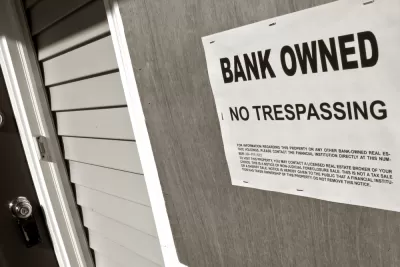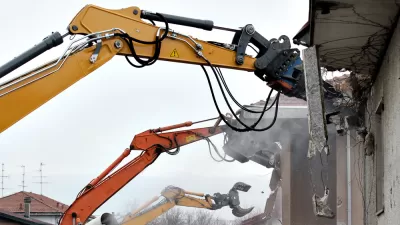It might seem obvious that vacant homes attract crime and other noxious elements to surrounding properties, but researchers are still working to quantify those external costs.

"That foreclosed house on your street with the chipped paint and boarded-up windows — it’s ugly, sure, but how much does it cost?"
That's the question posed by a new report written by Aaron Klein and covered by Rachel Dovey in an article for Next City. According to Dovey's summary, the report estimates that each vacant property "costs roughly $155,000 in its first year."
Those boarded-up windows are something of an “X marks the spot” for certain types of crimes, particularly the theft of appliances and copper pipes. The report estimates that, within 250 feet of a foreclosed home, the foreclosure process actually leads to a 10 percent increase in the number of reported crimes per year. And the impact of vacancy on crime increases as the property stays unoccupied, leveling out between a year and 18 months. Then, in a vicious cycle, that increase in crime can cause neighboring property values to decline.
The report, "Understanding the True Costs of Abandoned Properties: How Maintenance Can Make a Difference," was published by Community Blight Solutions.
FULL STORY: Dollar Amount Put on Cost of Blight to Neighbors

Planetizen Federal Action Tracker
A weekly monitor of how Trump’s orders and actions are impacting planners and planning in America.

Maui's Vacation Rental Debate Turns Ugly
Verbal attacks, misinformation campaigns and fistfights plague a high-stakes debate to convert thousands of vacation rentals into long-term housing.

San Francisco Suspends Traffic Calming Amidst Record Deaths
Citing “a challenging fiscal landscape,” the city will cease the program on the heels of 42 traffic deaths, including 24 pedestrians.

Amtrak Rolls Out New Orleans to Alabama “Mardi Gras” Train
The new service will operate morning and evening departures between Mobile and New Orleans.

The Subversive Car-Free Guide to Trump's Great American Road Trip
Car-free ways to access Chicagoland’s best tourist attractions.

San Antonio and Austin are Fusing Into one Massive Megaregion
The region spanning the two central Texas cities is growing fast, posing challenges for local infrastructure and water supplies.
Urban Design for Planners 1: Software Tools
This six-course series explores essential urban design concepts using open source software and equips planners with the tools they need to participate fully in the urban design process.
Planning for Universal Design
Learn the tools for implementing Universal Design in planning regulations.
Heyer Gruel & Associates PA
JM Goldson LLC
Custer County Colorado
City of Camden Redevelopment Agency
City of Astoria
Transportation Research & Education Center (TREC) at Portland State University
Jefferson Parish Government
Camden Redevelopment Agency
City of Claremont




























